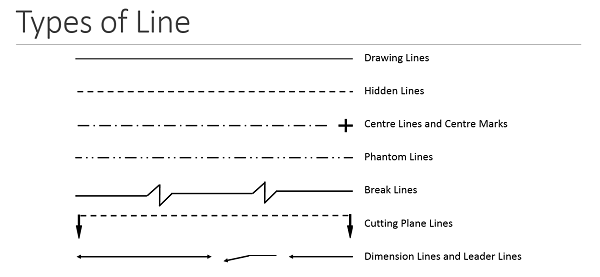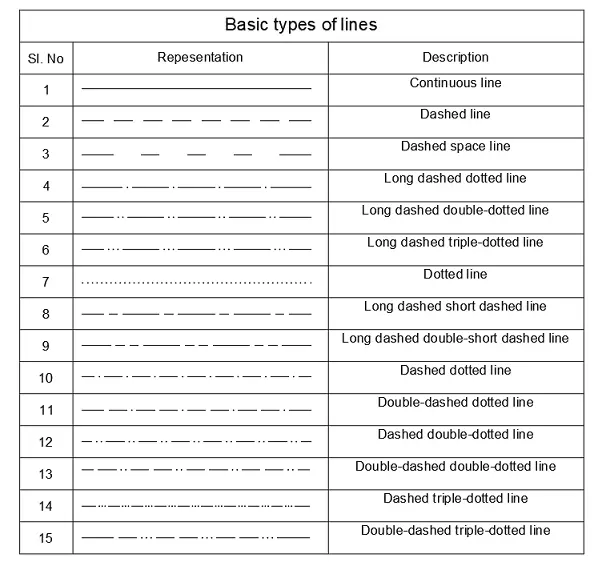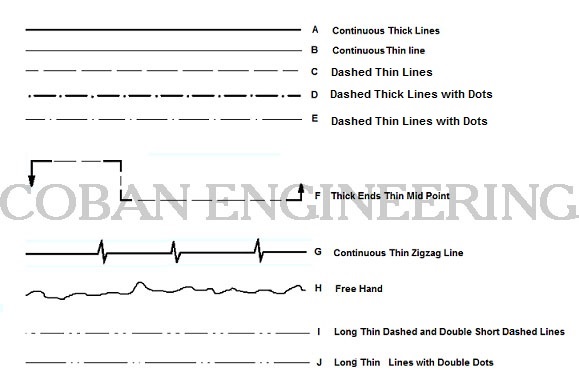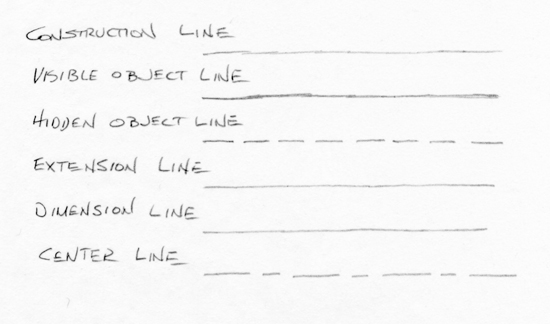A center line is a 3 mm to 5 mm line that alternates between short and long dashes. A type Continuos Thick B type Continuous THIN C type Continuous THIN Freehand D type Continuous THIN Zig-Zag E type Dashes THICK F type Dashes THIN G type Chain Thin H type Chain THIN and THICK J type Chain.
A hidden line.

. This video will help you to understand the difference between different types of lines used in technical drawing. BS 88882008 Technical product specification. LEADER LINE Medium line with arrowhead to show notes or label for size or special information about a feature.
Examples of this type of line can be seen in the movable jaw detailed drawing. A PFD normally comprise of but not limited to i all the process lines utilities and operating conditions essential for material balance and heat and material balance ii utility flow lines and their types which are used continuously within the battery limits iii equipment diagrams to be arranged according to process flow designation and equipment number iv. The line types are thick thin continuous straight curved zigzag discontinuous dotted and discontinuous chain dotted.
The Line type definition numbers are my own. Measure lines Backside section lines Implied axis lines to state the code of the planes at diagonal lines which are used to state plane surface Intersection Leader Hatching. Following are the different types of lines used in engineering drawing.
General principles of presentation. ORDER OF PRIORITY OF COINCIDING LINES When two or more lines of different types coincide the following order of priority should be observed. A measuring area or a limit of heat-treatment.
You are not limited to these line types. Following are the different types of lines used in engineering drawing. It is used to.
Line weight is the thickness of the line. SECTION LINE Medium lines drawn at 45 degrees use to show interior view of solid areas of cutting plane line. Object lines are solid heavy lines 7 mm to 9 mm.
You should make the line so that end. Thin lines for outlining. Thick lines for dimension.
E type Dashes THICK. A type Continuos Thick. BS EN ISO 128-202001 Technical drawings.
Thick lines are generally twice as wide as thin lines usually V32 inch or about 08 mm wide. The ISO type K lines are thin discontinuous and chain dotted with a double dot as shown in Figure 314. What are the 3 major line types that are used for technical drawings.
Centre Line or centreline Extension Line. See answer 1 Best Answer. Drawings for interior designprojects generally use three line widths.
Line types are also a language type to communicate between technical people. You can define your own but the British standards require that you add a key to your drawing to describe your custom line types meaning. This line is used to draw all the edges of the object.
Construction lines and guide lines are very light easily erased lines used to block in the main layout. Figure 3-7 These are common line types used in drawings to describe objects hidden conditions and important relationships between components and space. I Visible outlines and edges Continuous thick lines type A ii Hidden outlines and edges Dashed line type E or F iii Cutting planes Chain thin thick at ends and changes of cutting planes type H iv Centre.
PHANTOM LINE Long line followed by two short dashes use to show alternate position of a moving part. These lines define the shape of the object portrayed. H type Chain THIN and THICK.
This line is used mainly in sketching which is a freehand drawing technique. BS EN ISO 128-202001 Technical drawings. Visible lines are the edges or outlines of an object.
Each line type has clear meanings on the drawing and mixing up one type with another type is the equivalent of spelling something incorrectly in. D type Continuous THIN Zig-Zag. B type Continuous THIN.
General principles of presentation. Technical drawings are used widely throughout many industries by professionals including architects engineers CAD Technicians product designers and mathematicians. Fold Lines are lines used to represent an object flattened out into a 2D shape the bend lines are represented by long line and two short dashed line and then a long line again as shown on the left.
C type Continuous THIN Freehand. Using the Alphabet of Lines. A B C D E F G H I J K L M N O P Q R S.
Types of Lines in Technical Drawing Object Line. Surroundings and sides of the matters Outlines of the Edges End of the Screws B. Thick dark medium and thin light.
BS 88882008 Technical product specification. Text on Technical Drawings Standard engineering lettering uses single stroke Gothic upper case letters. Below is a list of the various types of technical drawing and their uses.
Once again you are free to make up your own line definitions but it is recommended that you put a note on the drawing with their meaning. They are used to indicate the important features of other parts. All other lines contrast with the visible lines by having either a thinner weight andor a combination of dashes.
Some of these professions can be broken down into various professions that all engage in technical drawing. In this followup to my first line types video I talk about a few more types of lines used in technical drawings. ISO 128 engineering drawing line type J reason eg.
G type Chain Thin. F type Dashes THIN. Start studying 12 Types of lines used in technical Drawing.
Learn vocabulary terms and more with flashcards games and other study tools. They are drawn as solid lines with a thickheavy weight. What are the six types of lines in technical drawing.

How To Read Engineering Drawings A Simple Guide Make Uk

Standard Engineering Drawing Line Types Line Art Lesson Types Of Lines Different Types Of Lines
Technical Drawing Standards Line Types

Types Of Line In Engineering No 1 Detailed Guide To Line Types

10 Different Types Of Lines Used In Engineering Drawing

Technical Drawings Lines Geometric Dimensioning And Tolerancing Definition Of The Drawings Lines Iso Ansi Projected Two View Drawing


0 comments
Post a Comment